The Pretare-Piedilama Clastic Deposit: New Evidence of a Quaternary Rock Avalanche Event in Central Apennines (Italy)
Abstract
:1. Introduction
2. Materials and Methods
3. Geological and Geomorphological Settings
4. Results
4.1. Local Geomorphology
4.2. Local Geology
4.3. The Pretare-Piedilama Rock Avalanche
4.3.1. General Features
4.3.2. Sedimentological and Textural Features
4.3.3. Morphometric Characterization of the Accumulation and Detachment Areas
5. Discussion and Conceptual Model
6. Final Remarks
Author Contributions
Funding
Data Availability Statement
Acknowledgments
Conflicts of Interest
References
- Hutchinson, J.N. General report: Morphological and geotechnical parameters of landslides in relation to geology and hydrogeology. In Proceedings of the 5th International Symposium on Landslides, Lausanne, Switzerland, 10–15 July 1988; pp. 3–35. [Google Scholar]
- Hungr, O.; Evans, S.G. Entrainment of debris in rock avalanches: An analysis of a long runout-out mechanism. Geol. Soc. Am. Bull. 2004, 116, 1240–1252. [Google Scholar] [CrossRef]
- Hungr, O.; Leroueil, S.; Picarelli, L. The Varnes classification of landslide types, an update. Landslides 2014, 11, 167–194. [Google Scholar] [CrossRef]
- Hermanns, R.L.; Niedermann, S.; Garcia, A.V.; Schellenberger, A. Rock avalanching in the NW Argentine Andes as a result of complex interactions of lithologic, structural and topographic boundary conditions, climate change and active tectonics. In Landslides from Massive Rock Slope Failure; Evans, S.G., Scarascia Mugnozza, G., Strom, A.L., Hermanns, R.L., Eds.; Nato Science Series Book IV Earth and Environmental Sciences 49; Springer Publisher: Dordrecht, The Netherlands, 2006; pp. 497–520. [Google Scholar]
- Mitchell, W.A.; Mc Saveney, M.J.; Zondervan, A.; Kim, K.; Dunning, S.A.; Taylor, P.J. The Keylong Serai rock avalanche, NW Indian Himalaya: Geomorphology and palaeoseismic implications. Landslides 2007, 4, 245–254. [Google Scholar] [CrossRef]
- Penna, I.M.; Hermanns, R.L.; Niedermann, S.; Folgueral, A. Multiple slope failures associated with neotectonic activity in the Southern Central Andes (37°–37°30′ S), Patagonia, Argentina. Bull. Geol. Soc. Am. 2011, 123, 1880–1895. [Google Scholar] [CrossRef]
- Pánek, T.; Lenart, J.; Hradecký, J.; Hercman, H.; Braucher, R.; Šilhán, K.; Škarpich, V. Coastal cliffs, rock-slope failures and Late Quaternary transgressions of the Black Sea along southern Crimea. Quat. Sci. Rev. 2018, 181, 76–92. [Google Scholar] [CrossRef]
- Delchiaro, M.; Della Seta, M.; Martino, S.; Dehbozorgi, M.; Nozaem, R. Reconstruction of river valley evolution before and after the emplacement of the giant Seymareh rock avalanche (Zagros Mts., Iran). Earth Surf. Dyn. 2019, 7, 929–947. [Google Scholar] [CrossRef]
- Chigira, M.; Kiho, K. Deep-seated rockslide-avalanches preceded by mass rock creep of sedimentary rocks in the Akaishi Mountains, central Japan. Eng. Geol. 1994, 38, 221–230. [Google Scholar] [CrossRef]
- Jain, S.K.; Nanda, A. A constitutive model for creep rupture. Mech. Adv. Mater. Struct. 2010, 17, 459–466. [Google Scholar] [CrossRef]
- Pedrazzini, A.; Jaboyedoff, M.; Loye, A.; Derron, M.H. From deep seated slope deformation to rock avalanche: Destabilization and transportation models of the Sierre landslide (Switzerland). Tectonophysics 2013, 605, 149–168. [Google Scholar] [CrossRef]
- Di Luzio, E.; Bianchi Fasani, G.; Saroli, M.; Esposito, C.; Cavinato, G.P.; Scarascia Mugnozza, G. Massive rock slope failure in the Central Apennines (Italy): The case of the Campo di Giove rock avalanche. Bull. Eng. Geol. Environ. 2004, 63, 1–12. [Google Scholar] [CrossRef]
- Bianchi Fasani, G.; Di Luzio, E.; Esposito, C.; Evans, S.G.; Scarascia Mugnozza, G. Quaternary, catastrophic rock avalanches in the Central Apennines (Italy): Relationships with inherited tectonic features, gravity-driven deformations and the geodynamic frame. Geomorphology 2014, 211, 22–42. [Google Scholar] [CrossRef]
- Esposito, C.; Di Luzio, E.; Scarascia Mugnozza, G.; Bianchi Fasani, G. Mutual interactions between slope-scale gravitational processes and morpho-structural evolution of central Apennines (Italy): Review of some selected case histories. Rend. Lincei. Sci. Fis. E Nat. 2014, 25, 151–165. [Google Scholar] [CrossRef]
- Ostermann, M.; Sanders, D. The Benner pass rock avalanche cluster suggests a close relation between long-term slope deformation (DSGSDs and translational rock slides) and catastrophic failure. Geomorphology 2017, 289, 44–59. [Google Scholar] [CrossRef]
- Glueer, F.; Loew, S.; Manconi, A.; Aaron, J. From toppling to sliding: Progressive evolution of the Moosfluh Landslide, Switzerland. J. Geophys. Res. Earth Surf. 2019, 124, 2899–2919. [Google Scholar] [CrossRef]
- Semenza, E.; Ghirotti, M. History of the 1963 Vajont slide: The importance of geological factors. Bull. Eng. Geol. Environ. 2000, 59, 87–97. [Google Scholar] [CrossRef]
- Genevois, R.; Ghirotti, M. The 1963 Vaiont landslide. G. Geol. Appl. 2005, 1, 41–52. [Google Scholar] [CrossRef]
- Dramis, F.; Govi, M.; Guglielmin, M.; Mortara, G. Mountain permafrost and slope instability in the Italian Alps: The Val Pola landslide. Permafr. Periglac. Process. 1995, 6, 73–81. [Google Scholar] [CrossRef]
- Crosta, G.B.; Chen, H.; Lee, C.F. Replay of the 1987 Val Pola Landslide, Italian Alps. Geomorphology 2004, 60, 127–146. [Google Scholar] [CrossRef]
- Nicoletti, P.G.; Parise, M.; Miccadei, E. The Scanno rock avalanche (Abruzzi, south-central Italy). Boll. Soc. Geol. Ital. 1993, 112, 523–525. [Google Scholar]
- Cinti, G.; Donati, A.; Scarascia Mugnozza, G. La grande frana di Monte Arezzo (Abruzzo). Mem. Soc. Geol. Ital. 2001, 56, 41–50. [Google Scholar]
- Paolucci, G.; Pizzi, R.; Scarascia Mugnozza, G. Analisi preliminare della frana di Lettopalena (Abruzzo). Mem. Soc. Geol. Ital. 2001, 56, 131–137. [Google Scholar]
- Giano, S.I.; Schiattarella, M. Drainage integration of small endorheic basins at the Pleistocene-Holocene transition: An example from southern Italy. Geomorphology 2023, 427, 108622. [Google Scholar] [CrossRef]
- Scarascia Mugnozza, G.; Bianchi Fasani, G.; Esposito, C.; Martino, S.; Saroli, M.; Di Luzio, E.; Evans, S.G. Rock avalanche and mountain slope deformation in a convex, dipslope: The case of the Majella massif (Central Italy). In Landslides from Massive Rock Slope Failure; Evans, S.G., Scarascia Mugnozza, G., Strom, A.L., Hermanns, R.L., Eds.; Nato Science Series Book IV Earth and Environmental Sciences 49; Springer Publisher: Dordrecht, The Netherlands, 2006; pp. 357–376. [Google Scholar]
- Della Seta, M.; Esposito, C.; Marmoni, G.M.; Martino, S.; Scarascia Mugnozza, G.; Troiani, F. Morpho-structural evolution of the valley-slope systems and related implications on slope-scale gravitational processes: New results from the Mt. Genzana case history (Central Apennines, Italy). Geomorphology 2017, 289, 60–77. [Google Scholar] [CrossRef]
- Antonielli, B.; Della Seta, M.; Esposito, C.; Scarascia Mugnozza, G.; Schilirò, L.; Spadi, M.; Tallini, M. Quaternary rock avalanches in the Apennines: New data and interpretation of the huge clastic deposit of the L’Aquila Basin (central Italy). Geomorphology 2020, 361, 107194. [Google Scholar] [CrossRef]
- McSaveney, M.J.; Davies, T.R.H. Rapid rock mass flow with dynamic fragmentation: Inferences from the morphology and internal structure of rockslides and rock avalanches. In Landslides from Massive Rock Slope Failure; Evans, S.G., Scarascia Mugnozza, G., Strom, A.L., Hermanns, R.L., Eds.; Nato Science Series Book IV Earth and Environmental Sciences 49; Springer Publisher: Dordrecht, The Netherlands, 2006; pp. 285–304. [Google Scholar]
- Owen, L.A.; Kamp, U.; Khattak, G.A.; Harp, E.L.; Keefer, D.K.; Bauer, M.A. Landslides triggered by the 8 October 2005 Kashmir earthquake. Geomorphology 2008, 94, 1–9. [Google Scholar] [CrossRef]
- Hewitt, K. Rock avalanche dams on the Trans Himalayan Upper Indus streams: A survey of Late Quaternary events and hazard-related characteristics. In Natural and Artificial Rockslide Dams; Evans, S., Hermanns, R., Strom, A., Scarascia Mugnozza, G., Eds.; Lecture Notes in Earth Sciences 133; Springer: Berlin/Heidelberg, Germany, 2011; pp. 177–204. [Google Scholar] [CrossRef]
- Ren, Z.; Wang, K.; Yang, K.; Zhou, Z.-H.; Tang, Y.-J.; Tian, L.; Xu, Z.-M. The grain size distribution and composition of the Touzhai rock avalanche deposit in Yunnan, China. Eng. Geol. 2018, 234, 97–111. [Google Scholar] [CrossRef]
- Dunning, S.A. The grain size distribution of rock-avalanche deposits in valley confined settings. Ital. J. Eng. Geol. Environ. 2006, 1, 117–121. [Google Scholar] [CrossRef]
- Schilirò, L.; Esposito, C.; De Blasio, F.V.; Scarascia Mugnozza, G. Sediment texture in rock avalanche deposits: Insights from field and experimental observations. Landslides 2019, 16, 1629–1643. [Google Scholar] [CrossRef]
- Shugar, D.H.; Clague, J.J. The sedimentology and geomorphology of rock avalanche deposits on glaciers. Sedimentology 2011, 58, 1762–1783. [Google Scholar] [CrossRef]
- Dunning, S.A.; Rosser, N.J.; McColl, S.T.; Reznichenko, N.V. Rapid sequestration of rock avalanche deposits within glaciers. Nat. Commun. 2015, 6, 7964. [Google Scholar] [CrossRef]
- McColl, S.T.; Davies, T.R.H. Evidence for a rock-avalanche origin for ‘The Hillocks’ “moraine”, Otago, New Zealand. Geomorphology 2011, 127, 216–224. [Google Scholar] [CrossRef]
- De Blasio, F.V.; Medici, L. Microscopic model of rock melting beneath landslides calibrated on the mineralogical analysis of the Köfels frictionite. Landslides 2016, 14, 337–350. [Google Scholar] [CrossRef]
- Dufresne, A.; Geertsema, M.; Shugar, D.H.; Koppes, M.; Higman, B.; Haeussler, P.J.; Stark, C.; Venditti, J.G.; Bonno, D.; Larseni, C.; et al. Sedimentology and geomorphology of a large tsunamigenic landslide, Taan Fiord, Alaska. Sediment. Geol. 2018, 364, 302–318. [Google Scholar] [CrossRef]
- Davies, T.; McSaveney, M.J. Runout of dry granular avalanches. Can. Geotech. J. 1999, 36, 313–320. [Google Scholar] [CrossRef]
- Legros, F. Can dispersive pressure cause inverse grading in grain flows? J. Sediment. Res. 2002, 72, 166–170. [Google Scholar] [CrossRef]
- Dufresne, A.; Davies, T.; McSaveney, M. Influence of runout-path material on emplacement of the Round Top rock avalanche, New Zealand. Earth Surf. Process. Landf. 2010, 35, 190–201. [Google Scholar] [CrossRef]
- Aaron, J.; Wolter, A.; Loew, S.; Volken, S. Understanding Failure and Runout Mechanisms of the Flims Rockslide/Rock Avalanche. Front. Earth Sci. 2020, 8, 224. [Google Scholar] [CrossRef]
- Mitchell, A.; McDougall, S.; Aaron, J.; Brideau, M.A. Rock Avalanche-Generated Sediment Mass Flows: Definitions and Hazard. Front. Earth Sci. 2020, 8, 543937. [Google Scholar] [CrossRef]
- Davies, T.; McSaveney, M.J.; Hodgson, K.A. A fragmentation-spreading model for long runout rock avalanches. Can. Geotech. J. 1999, 36, 1096–1110. [Google Scholar] [CrossRef]
- Evans, S.G.; Scarascia Mugnozza, G.; Strom, A.; Hermanns, R.L. Landslide from massive rock slope failure and associated phenomena. In Landslides from Massive Rock Slope Failure; Evans, S.G., Scarascia Mugnozza, G., Strom, A.L., Hermanns, R.L., Eds.; Nato Science Series Book IV Earth and Environmental Sciences; Springer Publisher: Dordrecht, The Netherlands, 2006; Volume 49, pp. 3–52. [Google Scholar]
- Mangeney, A.; Roche, O.; Hungr, O.; Mangold, N.; Faccanoni, G.; Lucas, A. Erosion and mobility in granular collapse over sloping beds. J. Geophys. Res. Earth Surf. 2010, 115, F03040. [Google Scholar] [CrossRef]
- Bowman, E.T.; Take, W.A.; Rait, K.L.; Hann, C. Physical models of rock avalanche spreading behaviour with dynamic fragmentation. Can. Geotech. J. 2012, 49, 460–476. [Google Scholar] [CrossRef]
- Schleier, M.; Hermanns, R.L.; Rohn, J. Spatial distribution of rockslide deposits suggest timing and paleo-environmental conditions for rock slope failures in Innerdalen and Innfjorddalen, Møre og Romsdal county, western Norway. Ital. J. Eng. Geol. Environ. 2013, Book Series 6, 493–505. [Google Scholar] [CrossRef]
- Dufresne, A.; Dunning, S.A. Process dependence of grain size distributions in rock avalanche deposits. Landslides 2017, 14, 1555–1563. [Google Scholar] [CrossRef]
- Orwin, J.F.; Clague, J.J.; Gerath, R.F. The Cheam rock avalanche, Fraser Valley, British Columbia, Canada. Landslides 2004, 1, 289–298. [Google Scholar] [CrossRef]
- Strom, A.L.; Korup, O. Extremely large rockslides and rock avalanches in the Tien Shan Mountains, Kyrgyzstan. Landslides 2006, 3, 125–136. [Google Scholar] [CrossRef]
- Dai, F.C.; Tu, X.B.; Xu, C.; Gong, Q.M.; Yao, X. Rock avalanches triggered by oblique thrusting during the 12 May 2008 Ms 8.0 Wenchuan earthquake, China. Geomorphology 2011, 132, 300–318. [Google Scholar] [CrossRef]
- Bianchi Fasani, G. Grandi Frane in Roccia: Fenomenologia ed Evidenze di Terreno. Ph.D. Thesis, University of Rome “Sapienza”, Rome, Italy, 2004; 192p. [Google Scholar]
- Crosta, G.B.; Frattini, P.; Fusi, N. Fragmentation in the Val Pola rock avalanche. Italian Alps. J. Geophys. Res. 2007, 112, F01006. [Google Scholar] [CrossRef]
- Knapp, S.; Krautblatter, M. Conceptual Framework of Energy Dissipation During Disintegration in Rock Avalanches. Front. Earth Sci. 2020, 8, 263. [Google Scholar] [CrossRef]
- Vezzani, L.; Festa, A.; Ghisetti, F.C. Geology and tectonic Evolution of the Central-Southern Apennines, Italy; The Geological Society of America: Boulder, CO, USA, 2010; Volume 469. [Google Scholar] [CrossRef]
- Pierantoni, P.; Deiana, G.; Galdenzi, S. Stratigraphic and structural features of the Sibillini Mountains (Umbria-Marche Apennines, Italy). Ital. J. Geosci. 2013, 132, 497–520. [Google Scholar] [CrossRef]
- Tortorici, G.; Romagnoli, G.; Grassi, S.; Imposa, S.; Lombardo, G.; Panzera, F.; Catalano, S. Quaternary negative tectonic inversion along the Sibillini Mts. thrust zone: The Arquata del Tronto case history (Central Italy). Environ. Earth Sci. 2019, 78, 37. [Google Scholar] [CrossRef]
- Galli, P.; Peronace, E.; Bramerini, F.; Castenetto, S.; Naso, G.; Cassone, F.; Pallone, F. The MCS intensity distribution of the devastating 24 August 2016 earthquake in central Italy (MW 6.2). Ann. Geophys. 2016, 59, 5. [Google Scholar] [CrossRef]
- Rossi, A.; Tertulliani, A.; Azzaro, R.; Graziani, L.; Rovida, A.; Maramai, A.; Pessina, V.; Hailemikael, S.; Buffarini, G.; Bernardini, F.; et al. The 2016–2017 earthquake sequence in Central Italy: Macroseismic survey and damage scenario through the EMS-98 intensity assessment. Bull. Earthq. Eng. 2019, 17, 2407–2431. [Google Scholar] [CrossRef]
- Luzi, L.; Pacor, F.; Lanzano, G.; Felicetta, C.; Puglia, R.; D’Amico, M. Central Italy seismic sequence: Strong motion data analysis and design earthquake selection for seismic microzonation purposes. Bull. Earthq. Eng. 2020, 18, 5533–5551. [Google Scholar] [CrossRef]
- Regione Marche: Microzonazione Sismica. Available online: https://qmap-protciv.regione.marche.it/cs/ (accessed on 18 May 2020).
- Centamore, E.; Cantalamessa, G.; Micarelli, A.; Potetti, M.; Berti, D.; Bigi, S.; Morelli, C.; Ridolfi, M. Stratigrafia e analisi di facies dei depositi del Miocene e del Pliocene inferiore dell’avanfossa marchigiano- abruzzese e delle zone limitrofe. Studi Geol. Camerti 1991, 2, 125–131. [Google Scholar]
- Milli, S.; Moscatelli, M.; Stanzione, O.; Falcini, F. Sedimentology and physical stratigraphy of the Messinian turbidite deposits of the Laga Basin (central Apennines, Italy). Boll. Soc. Geol. Ital. 2007, 126, 255–281. [Google Scholar]
- Marini, M.; Felletti, F.; Milli, S.; Patacci, M. The thick-bedded tail of turbidite thickness distribution as a proxy for flow confinement: Examples from tertiary basins of central and northern Apennines (Italy). Sediment. Geol. 2016, 341, 96–118. [Google Scholar] [CrossRef]
- ISPRA; Marino, M.; Muraro, C.; Papasodaro, F. Substrato Carbonatico e Depositi Quaternari Associati; M.L. Putignano, D. Domenico, M. Cesarano, M. Mancini: Substrato Silicoclastico e Depositi Quaternari Associate (a Cura di). “Note Illustrative Della Carta Geologica D’italia Alla Scala 1:50.000″ F. 347 Norcia. 2021; p. 351. Available online: https://www.isprambiente.gov.it/Media/carg/note_illustrative/337_Norcia.pdf (accessed on 10 February 2023).
- ASTM D422-63; Standard Test Method for Particle-Size Analysis of Soils (Withdrawn 2016). ASTM International: West Conshohocken, PA, USA, 2007. [CrossRef]
- Hutchinson, M.F.; Hoog, F. Smoothing Noisy Data with Spline Functions. Numer. Math. 1985, 47, 99–106. [Google Scholar] [CrossRef]
- Hutchinson, M.F. Adding the Z-dimension. In Handbook of Geographic Information Science; Wilson, J.P., Fotheringham, A.S., Eds.; Blackwell: Oxford, UK, 2008; pp. 144–168. [Google Scholar]
- Boccaletti, M.; Calamita, F.; Deiana, G.; Gelati, R.; Massari, F.; Moratti, G.; Ricci Lucchi, F. Migrating foredeep-thrust belt systems in the northern Apennines and southern Alps. Palaeogeogr. Palaeoclimatol. Palaeoecol. 1990, 77, 3–14. [Google Scholar] [CrossRef]
- Patacca, E.; Sartori, R.; Scandone, P. Tyrrhenian Basin and Apenninic Arcs: Kinematic Relations since Late Tortonian Times. Mem. Soc. Geol. Ital. 1990, 45, 425–451. [Google Scholar]
- Calamita, F.; Deiana, G. Correlazione tra gli eventi deformativi neogenico-quaternari del settore tosco-umbro-marchigiano. Studi Geol. Camerti 1995, 1, 137–152. [Google Scholar]
- Ricci Lucchi, F. Miocene Paleogeography and basin analysis in the Periadriatic Apennines. In Geology of Italy; Squires, C., Ed.; Petroleum exploration society of Libya: Tripoli, Libya, 1975; pp. 5–111. [Google Scholar]
- Cantalamessa, G.; Centamore, E.; Chiocchini, U.; Di Lorito, L.; Leonelli, M.; Micarelli, A.; Pesaresi, A.; Potetti, M.; Taddei, L.; Venanzini, D. (1980)—Analisi dell’evoluzione tettonico-sedimentaria dei “bacini minori” torbiditici del Miocene medio-superiore nell’Appennino umbro-marchigiano e laziale-abruzzese: 8) Il bacino della Laga tra il F. Fiastrone-T. Fiastrella ed il T. Fluvione. Studi Geol. Camerti 1980, 6, 81–133. [Google Scholar]
- Koopman, A. Detachment tectonics in the central Apennines, Italy. Geol. Ultraiectina 1983, 30, 1–155. [Google Scholar]
- Lavecchia, G. Il sovrascorrimento dei Monti Sibillini: Analisi strutturale e cinematica. Boll. Soc. Geol. Ital. 1985, 104, 161–194. [Google Scholar]
- Turtù, A.; Satolli, S.; Maniscalco, R.; Calamita, F.; Speranza, F. Understanding progressive-arc- and strike-slip-related rotations in curve-shaped orogenic belts: The case of the Olevano-Antrodoco-Sibillini thrust (Northern Apennines, Italy). J. Geophys. Res. Solid Earth 2013, 118, 459–473. [Google Scholar] [CrossRef]
- Di Domenica, A.; Bonini, L.; Calamita, F.; Toscani, G.; Galuppo, C.; Seno, S. Analogue modeling of positive inversion tectonics along differently oriented pre-thrusting normal faults: An application to the Central-Northern Apennines of Italy. Geol. Soc. Am. Bull. 2014, 126, 946–955. [Google Scholar] [CrossRef]
- Galadini, F.; Galli, P. Active Tectonics in the Central Apennines (Italy)–Input Data for Seismic Hazard Assessment. Nat. Hazards 2000, 22, 225–268. [Google Scholar] [CrossRef]
- Rovida, A.; Locati, M.; Camassi, R.; Lolli, B.; Gasperini, P. The Italian earthquake catalogue CPTI15. Bull. Earthq. Eng. 2020, 18, 2953–2984. [Google Scholar] [CrossRef]
- Aringoli, D.; Cavitolo, P.; Farabollini, P.; Gentili, B.; Giano, S.; Lopez-Garrido, A.; Materazzi, M.; Nibbi, L.; Pedrera, A.; Pambianchi, G.; et al. Morphotectonic characterization of the quaternary intermontane basins in the Umbria-Marche Apennines (Italy). Rend. Lincei Sci. Fis. Nat. 2014, 25 (Suppl. 2), 111–128. [Google Scholar] [CrossRef]
- Pizzi, A.; Galadini, F. Pre-existing cross-structures and active fault segmentation in the Northern central Apennines. Tectonophysics 2009, 476, 302–319. [Google Scholar] [CrossRef]
- Cacciuni, A.; Centamore, E.; Di Stefano, R.; Dramis, F. Evoluzione morfotettonica della conca di Amatrice. Studi Geol. Camerti 1995, 2, 95–100. [Google Scholar]
- Sembroni, A.; Molin, P.; Soligo, M.; Tuccimei, P.; Anzalone, E.; Billi, A.; Franchini, S.; Ranaldi, M.; Tarchini, L. The uplift of the Adriatic flank of the Apennines since Middle Pleistocene: New insights from the Tronto River basin and the Acquasanta Terme Travertine (central Italy). Geomorphology 2019, 352, 106990. [Google Scholar] [CrossRef]
- Coltorti, M.; Pieruccini, P. The planation surface across the italian peninsula: A key tool in neotectonics studies. J. Geodyn. 2000, 29, 323–328. [Google Scholar] [CrossRef]
- Dramis, F.; Pambianchi, G.; Nesci, O.; Consoli, M. Il ruolo di elementi strutturali trasversali nell’evoluzione tettonico-sedimentaria e geomorfologica della regione marchigiana. Studi Geol. Camerti 1991, 2, 287–293. [Google Scholar]
- Aringoli, D.; Farabollini, P.; Pambianchi, G.; Materazzi, M.; Bufalini, M.; Fuffa, E.; Gentilucci, M.; Scalella, G. Geomorphological Hazard in Active Tectonics Area: Study Cases from Sibillini Mountains Thrust System (Central Apennines). Land 2021, 10, 510. [Google Scholar] [CrossRef]
- Cesarano, M.; Putignano, M.L. Tettonica Compressive e Distensiva Post-Orogenica Del Bacino Della Laga. In: M. Marino, C., Muraro, F. Papasodaro: Substrato Carbonatico e Depositi Quaternari Associati; M.L. Putignano, D. Domenico, M. Cesarano, M. Mancini: Substrato Silicoclastico e Depositi Quaternari Associate (a cura di). “Note Illustrative Della Carta Geologica d’Italia alla scala 1:50.000” F. 347 Norcia; 2021; pp. 221–232. Available online: https://www.isprambiente.gov.it/Media/carg/note_illustrative/337_Norcia.pdf (accessed on 10 February 2023).
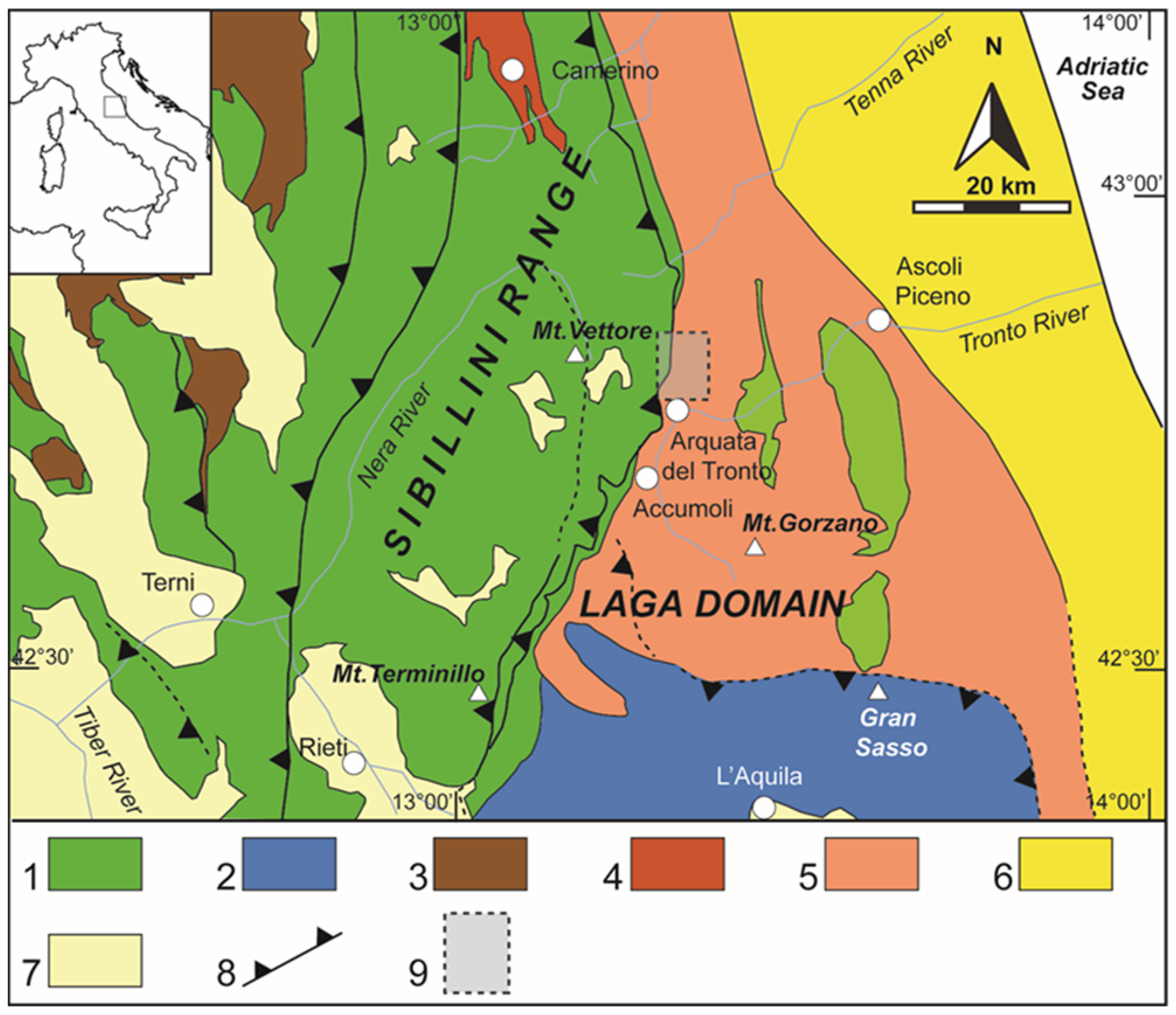



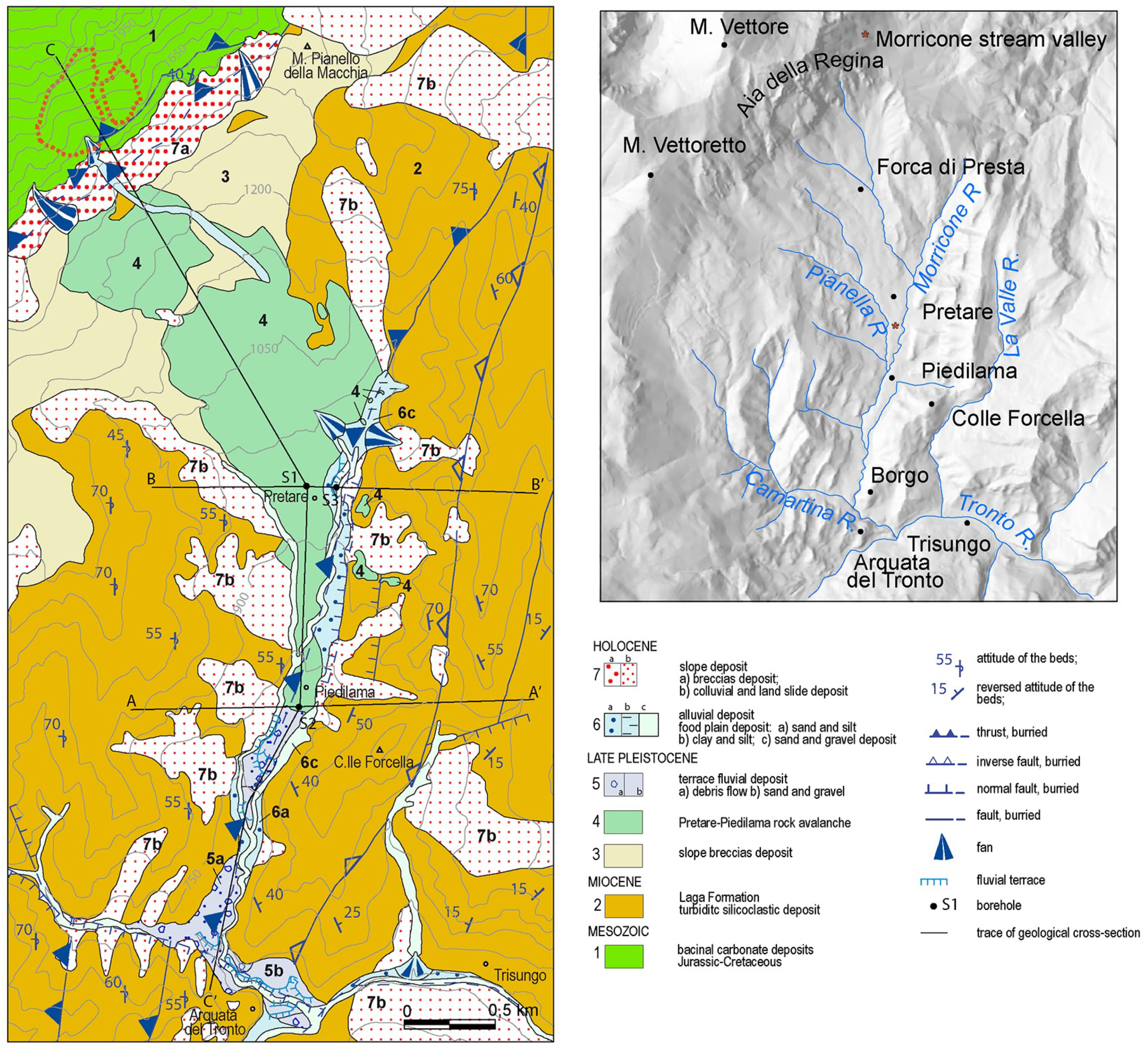
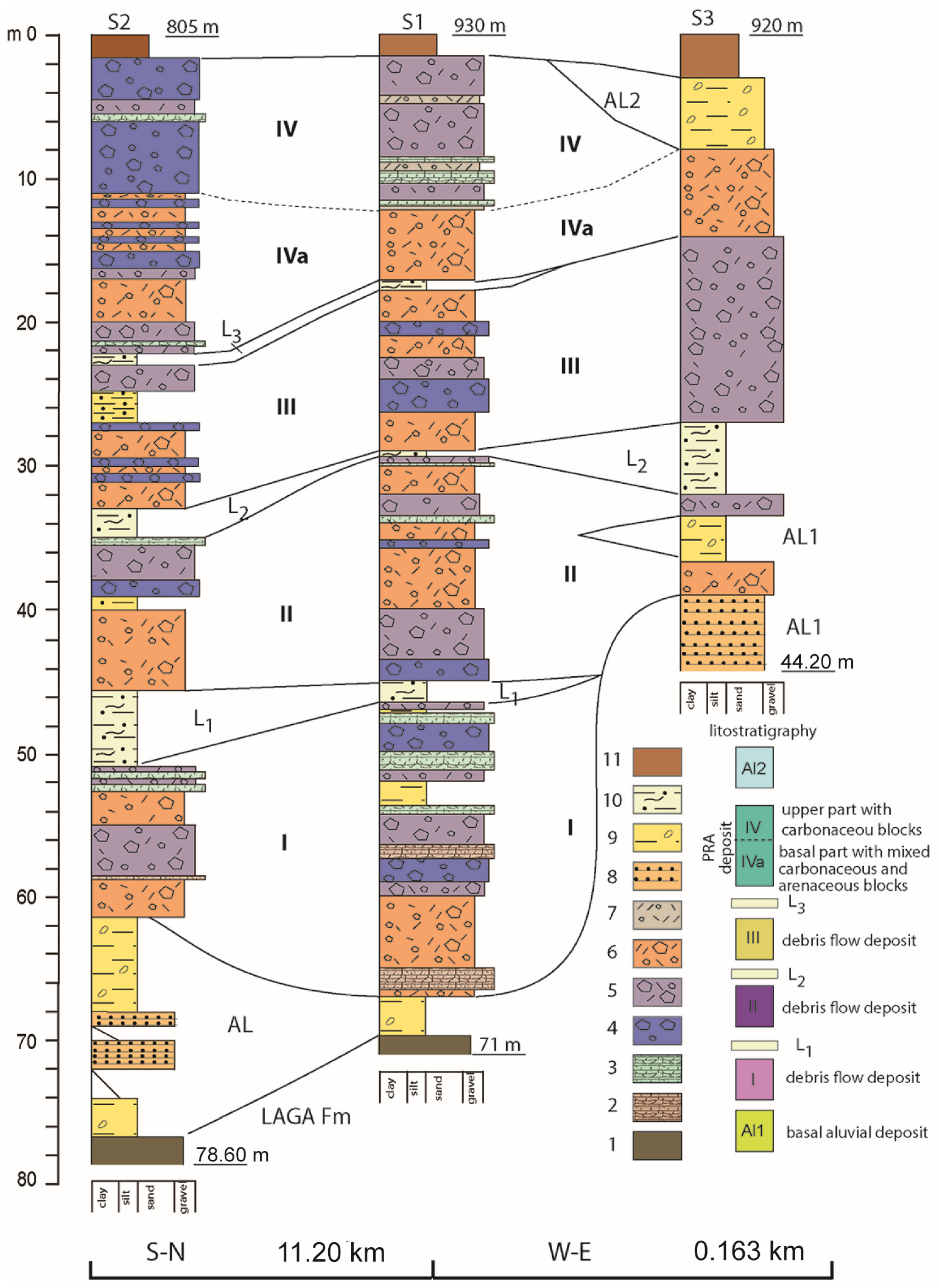


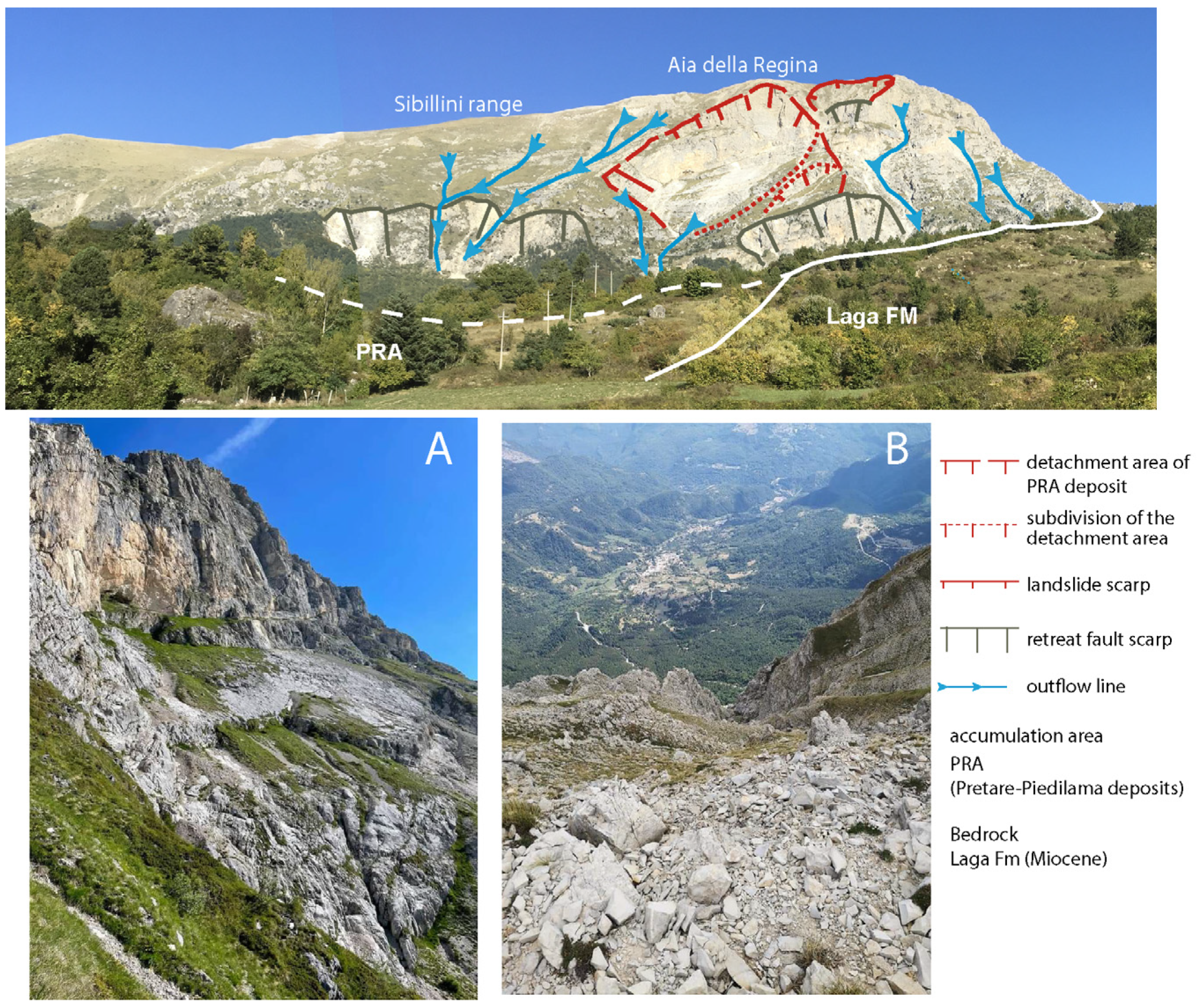
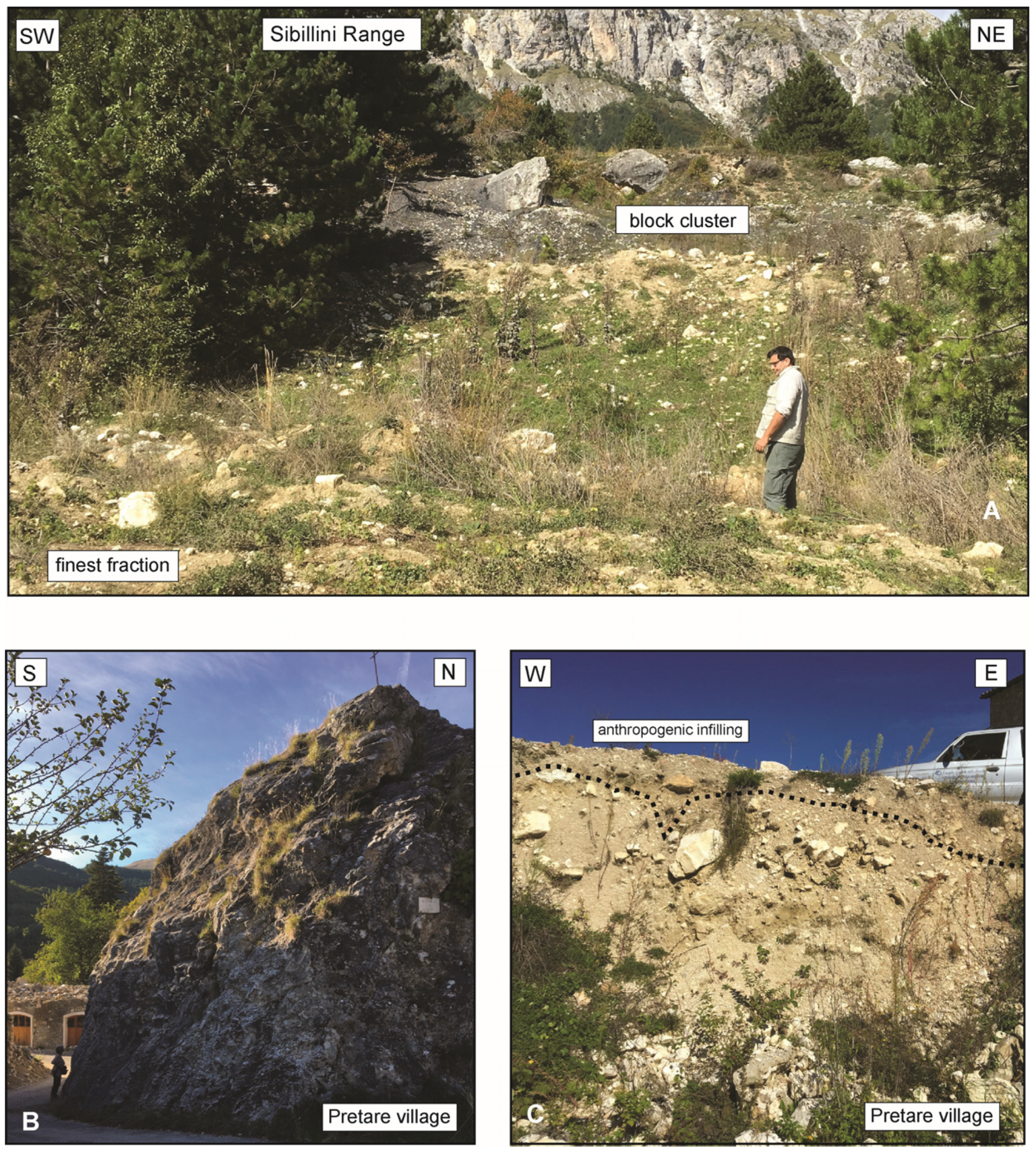


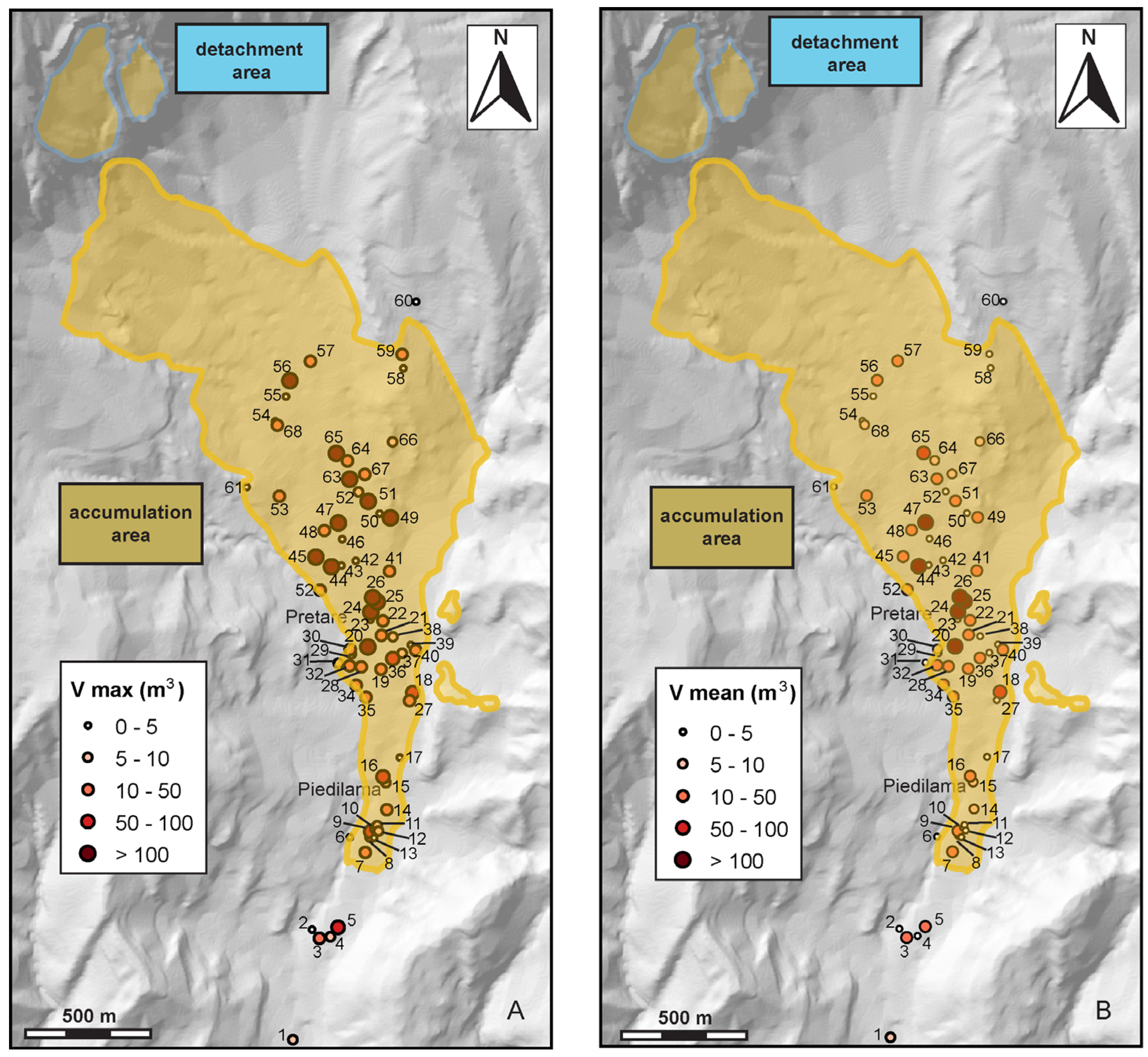
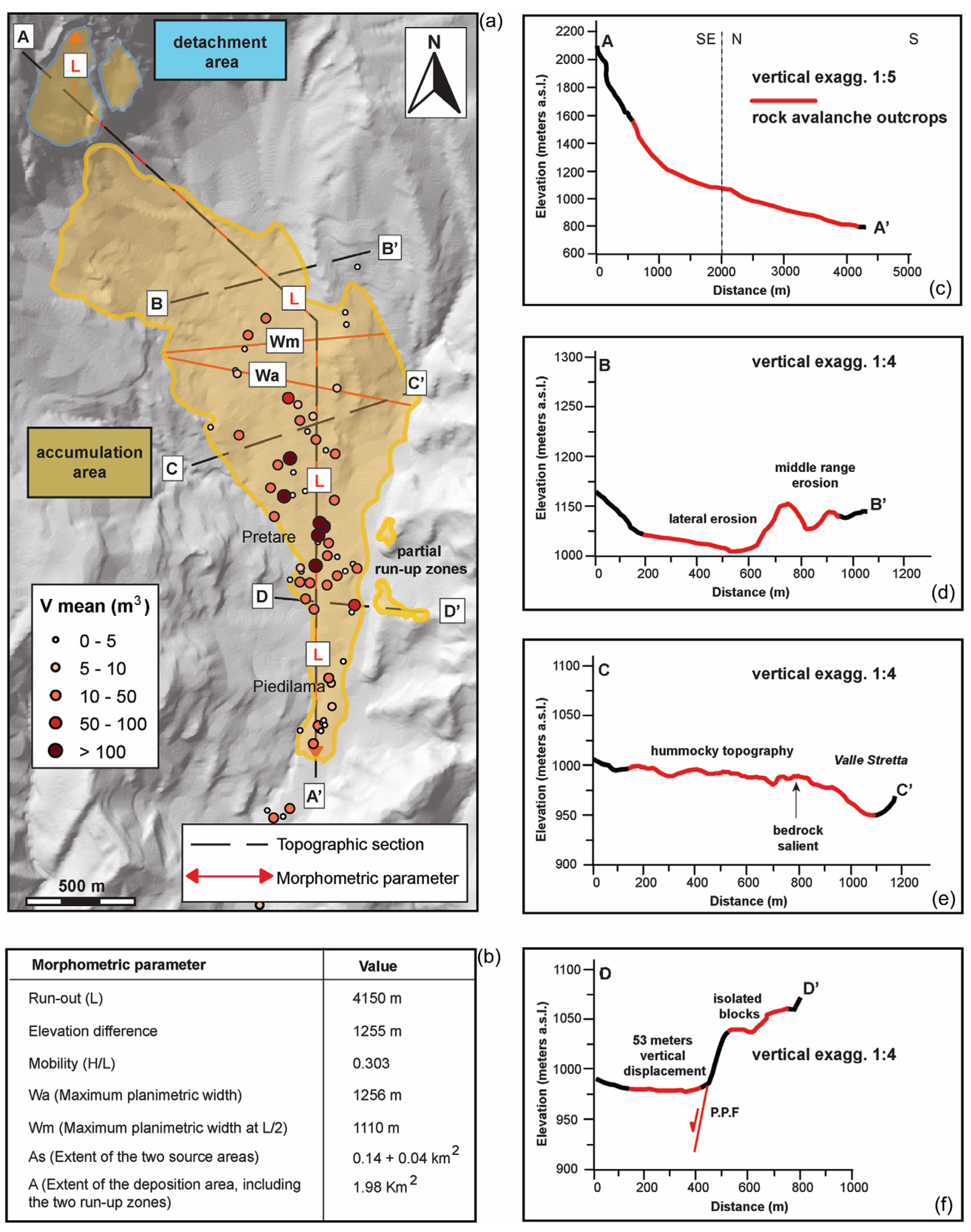
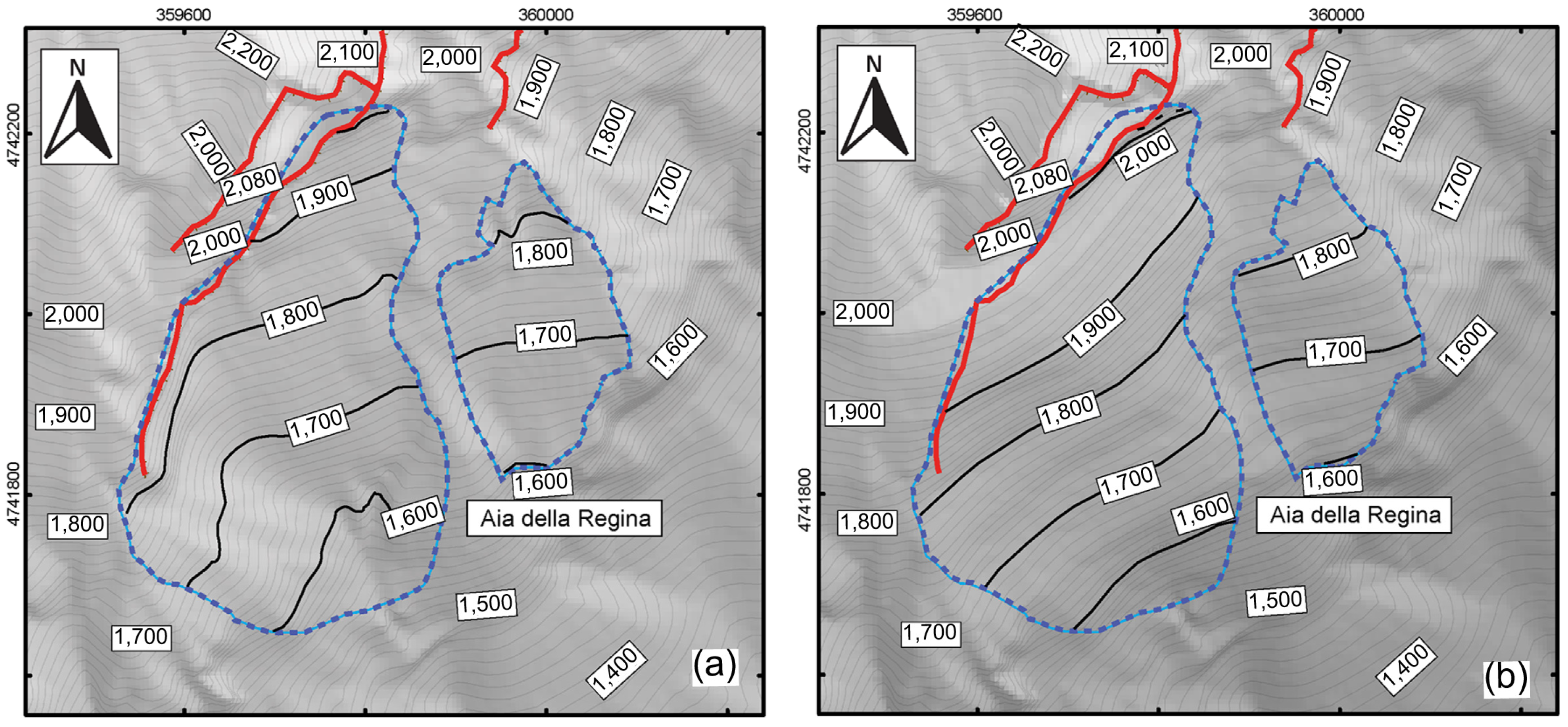
| Volume Distribution | |||||||
|---|---|---|---|---|---|---|---|
| Total n. of blocks: 350 Minimum value: 0.03 m3 1st quartile (Q1): 1.08 m3 | 2nd quartile (Q2): 2.25 m3 3rd quartile (Q3): 5.34 m3 Maximum value: 960 m3 | ||||||
| Station | n. blocks | Vmean (m3) | Vmax (m3) | Station | n. blocks | Vmean (m3) | Vmax (m3) |
| 1 | 5 | 2.1 | 7.2 | 35 | 1 | 16.2 | 16.2 |
| 2 | 5 | 1.5 | 2.4 | 36 | 4 | 21.3 | 81.0 |
| 3 | 1 | 30.6 | 30.6 | 37 | 4 | 4.0 | 10.0 |
| 4 | 4 | 2.1 | 7.2 | 38 | 3 | 4.6 | 7.4 |
| 5 | 2 | 39.3 | 78.4 | 39 | 1 | 3.0 | 3.0 |
| 6 | 3 | 0.6 | 0.8 | 40 | 1 | 24.0 | 24.0 |
| 7 | 1 | 37.1 | 37.1 | 41 | 3 | 16.9 | 24.0 |
| 8 | 4 | 4.9 | 17.1 | 42 | 1 | 4.5 | 4.5 |
| 9 | 5 | 18.6 | 91.0 | 43 | 1 | 4.5 | 4.5 |
| 10 | 3 | 4.3 | 11.9 | 44 | 3 | 260.1 | 360.0 |
| 11 | 5 | 2.0 | 7.5 | 45 | 16 | 38.8 | 150.0 |
| 12 | 2 | 4.8 | 6.9 | 46 | 10 | 2.2 | 2.2 |
| 13 | 12 | 1.1 | 1.1 | 47 | 1 | 108.0 | 108.0 |
| 14 | 12 | 5.1 | 25.4 | 48 | 2 | 25.8 | 40.5 |
| 15 | 1 | 7.5 | 7.5 | 49 | 21 | 39.0 | 560.0 |
| 16 | 3 | 33.2 | 99.0 | 50 | 12 | 2.2 | 2.2 |
| 17 | 1 | 2.2 | 2.2 | 51 | 3 | 44.3 | 102.0 |
| 18 | 1 | 52.5 | 52.5 | 52 | 1 | 12.0 | 12.0 |
| 19 | 1 | 20.0 | 20.0 | 53 | 1 | 12.0 | 12.0 |
| 20 | 1 | 160.0 | 160.0 | 54 | 5 | 4.5 | 4.5 |
| 21 | 4 | 16.1 | 27.5 | 55 | 16 | 3.5 | 4.5 |
| 22 | 2 | 16.2 | 22.5 | 56 | 10 | 15.8 | 144.0 |
| 23 | 4 | 2.4 | 4.5 | 57 | 6 | 13.7 | 43.2 |
| 24 | 2 | 484.0 | 800.0 | 58 | 4 | 0.6 | 0.6 |
| 25 | 6 | 161.6 | 960.0 | 59 | 26 | 2.5 | 18 |
| 26 | 3 | 334.3 | 882.0 | 60 | 1 | 0.4 | 0.4 |
| 27 | 9 | 4.9 | 22.5 | 61 | 7 | 3.6 | 5.0 |
| 28 | 6 | 0.8 | 2.3 | 62 | 10 | 1.2 | 9.0 |
| 29 | 9 | 3.1 | 9.0 | 63 | 8 | 29.9 | 153.6 |
| 30 | 10 | 9.0 | 30.0 | 64 | 7 | 7.2 | 30.0 |
| 31 | 7 | 2.4 | 7.2 | 65 | 5 | 70.9 | 308.0 |
| 32 | 1 | 15.0 | 15.0 | 66 | 3 | 5.8 | 10.0 |
| 33 | 1 | 21.0 | 21.0 | 67 | 8 | 6.5 | 15.0 |
| 34 | 1 | 15.0 | 15.0 | 68 | 8 | 5.1 | 14.0 |
Disclaimer/Publisher’s Note: The statements, opinions and data contained in all publications are solely those of the individual author(s) and contributor(s) and not of MDPI and/or the editor(s). MDPI and/or the editor(s) disclaim responsibility for any injury to people or property resulting from any ideas, methods, instructions or products referred to in the content. |
© 2023 by the authors. Licensee MDPI, Basel, Switzerland. This article is an open access article distributed under the terms and conditions of the Creative Commons Attribution (CC BY) license (https://creativecommons.org/licenses/by/4.0/).
Share and Cite
Putignano, M.L.; Di Luzio, E.; Schilirò, L.; Pietrosante, A.; Giano, S.I. The Pretare-Piedilama Clastic Deposit: New Evidence of a Quaternary Rock Avalanche Event in Central Apennines (Italy). Water 2023, 15, 753. https://doi.org/10.3390/w15040753
Putignano ML, Di Luzio E, Schilirò L, Pietrosante A, Giano SI. The Pretare-Piedilama Clastic Deposit: New Evidence of a Quaternary Rock Avalanche Event in Central Apennines (Italy). Water. 2023; 15(4):753. https://doi.org/10.3390/w15040753
Chicago/Turabian StylePutignano, Maria Luisa, Emiliano Di Luzio, Luca Schilirò, Andrea Pietrosante, and Salvatore Ivo Giano. 2023. "The Pretare-Piedilama Clastic Deposit: New Evidence of a Quaternary Rock Avalanche Event in Central Apennines (Italy)" Water 15, no. 4: 753. https://doi.org/10.3390/w15040753
APA StylePutignano, M. L., Di Luzio, E., Schilirò, L., Pietrosante, A., & Giano, S. I. (2023). The Pretare-Piedilama Clastic Deposit: New Evidence of a Quaternary Rock Avalanche Event in Central Apennines (Italy). Water, 15(4), 753. https://doi.org/10.3390/w15040753







